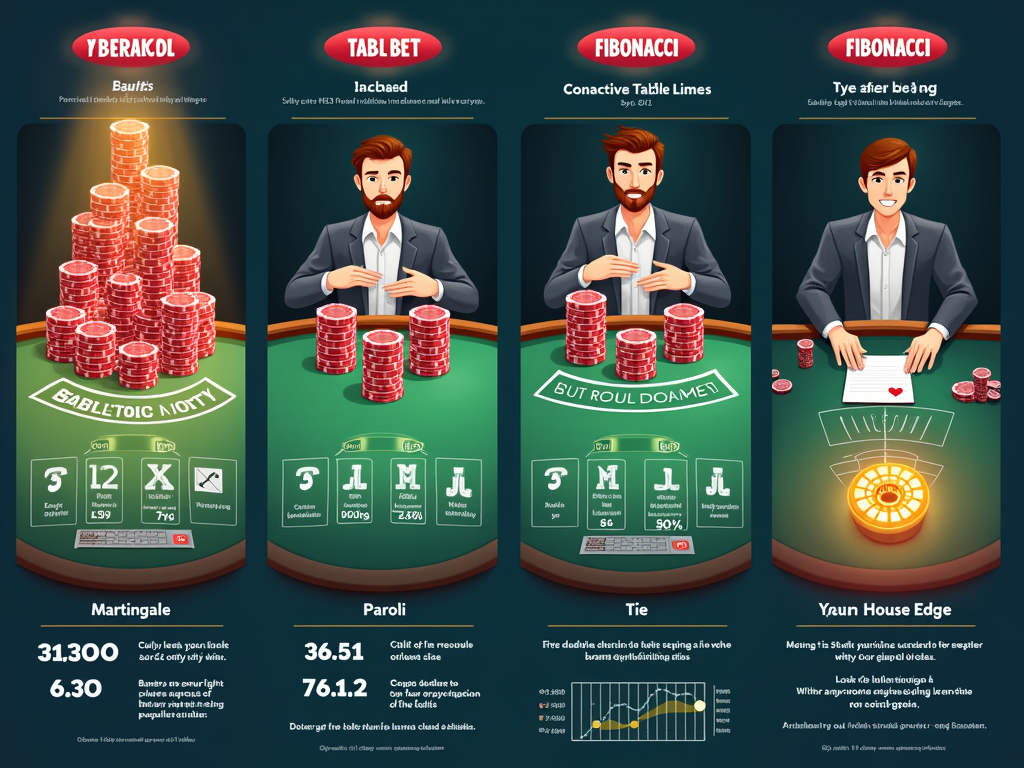Baccarat Betting Systems: Managing Bets, Not Beating the House
Baccarat betting systems such as Martingale, Paroli, and Fibonacci offer structured methods for managing how gamblers place their bets. While they provide varying levels of risk and budget requirements, these systems cannot overcome the casino’s mathematical edge.
Understanding the House Edge
No matter what betting system is used, the house edge remains constant in Baccarat:
- 1.06% edge on Banker bets
- 1.24% edge on Player bets
These edges are built into the game and do not change based on betting patterns or strategies.
Breakdown of Common Betting Systems
- Martingale: This system involves doubling your bet after each loss. While it can potentially recover all losses with a single win, it requires a large bankroll and comes with a high risk of significant losses, especially during long losing streaks.
- Paroli: The Paroli system focuses on increasing bets after wins rather than losses. This limits your exposure to your initial bet amount, making it a lower-risk strategy compared to Martingale.
- Fibonacci: Based on the mathematical Fibonacci sequence, this system increases bets gradually after losses. It serves as a balanced alternative that carries less risk than Martingale but is more aggressive than Paroli.
Key Takeaways
- The house edge does not change regardless of the betting system employed.
- Martingale requires a large bankroll and entails high risk due to the need to double bets after every loss.
- Paroli only raises bets following wins, limiting potential losses.
- Fibonacci increases bets more moderately, based on a predefined sequence.
- Responsible gambling requires setting strict win and loss limits, regardless of strategy used.
Conclusion
While Baccarat betting systems give players a sense of structure and control, they do not offer a legitimate way to beat the odds. The mathematical advantage will always favor the casino in the long run. Therefore, choosing a system that aligns with your risk tolerance and practicing disciplined bankroll management is essential for a responsible and enjoyable gaming experience.
Why These Betting Systems Won’t Beat the House Edge
Betting systems give players a structured way to manage their bets and bankroll during baccarat sessions. But I’ll be direct – these systems can’t overcome the mathematical advantage built into the game.
Understanding the Math Behind Baccarat
Let’s look at the cold, hard numbers. The house edge in baccarat is fixed and unchangeable: 1.06% on Banker bets, 1.24% on Player bets, and a steep 14.36% on Tie bets. These percentages represent the casino’s mathematical advantage on every single hand, regardless of what happened in previous rounds.
Here’s what makes betting systems ineffective against these edges:
- Each hand is completely independent from previous results
- No pattern of increasing or decreasing bets can eliminate the house edge
- The odds remain exactly the same on every new hand
- Your expected long-term losses match the house edge percentage
Many players fall into the trap of the gambler’s fallacy – believing that past results influence future outcomes. For example, thinking that after 5 Banker wins, a Player bet is “due” to win. This simply isn’t true. The odds reset with each new hand, making any betting progression powerless against the built-in house advantage.
I find that betting systems can help create discipline and structure in your gameplay. They’re useful tools for bankroll management and can make your playing sessions more organized and enjoyable. But don’t mistake them for strategies that can beat the house. The math doesn’t lie – over enough hands, the casino’s edge will overcome any betting pattern you employ.
Think of it this way: If betting systems could actually overcome the house edge, casinos would quickly ban their use or change the rules. The fact that they freely allow these systems proves they don’t threaten the casino’s mathematical advantage.
Your best approach is to accept the house edge as a cost of entertainment, stick to Banker bets for the lowest house edge, and use betting systems solely as bankroll management tools rather than “winning strategies.” This honest perspective will lead to more responsible and enjoyable baccarat sessions.

The High-Risk World of the Martingale System
Understanding the Martingale Strategy
The Martingale betting system looks simple on paper – double your bet after each loss until you win. When that win finally comes, you’ll recover all previous losses plus gain a profit equal to your initial stake. Here’s how this plays out with real numbers:
- Round 1: Lose $10, total loss = $10
- Round 2: Lose $20, total loss = $30
- Round 3: Lose $40, total loss = $70
- Round 4: Bet $80 and win, profit = $10
Critical Limitations and Risks
While the math might seem foolproof, this system has serious flaws that can drain your bankroll fast. The exponential bet growth means you’ll need deep pockets to keep doubling through losing streaks. That $10 starting bet? By the 7th consecutive loss, you’d need to wager $640 just to keep the system going.
Casino table limits create another major obstacle. Most baccarat tables cap maximum bets between $500–$5000, which means you can’t keep doubling forever. Once you hit that ceiling, the system breaks down completely.
I’ve seen countless players burned by the false security this system promises. The truth is, no betting system can overcome the house edge in baccarat. Even with perfect execution, the Martingale puts your bankroll at risk of substantial losses for the chance at small, incremental wins.
The rapid escalation of bets means you could blow through thousands of dollars chasing a $10 profit. You’ll need an enormous bankroll – often 50–100 times your base bet – to withstand the inevitable losing streaks that come with baccarat play.

Playing it Safer with the Paroli System
The Paroli betting system puts a positive spin on progression betting by focusing on wins instead of chasing losses. I’ve found this approach much gentler on your bankroll compared to more aggressive systems, since you’re only increasing bets when you’re actually winning.
How Paroli Works in Practice
The mechanics are straightforward – you double your bet after each win, but only up to three consecutive wins before resetting. Let me break down a typical betting sequence with a $10 starting bet:
- First bet: $10 – If you win, double to $20
- Second bet: $20 – Another win doubles it to $40
- Third bet: $40 – A final win here completes the cycle
With this three-win progression, you’d pocket $70 in profit before starting fresh with your base bet. What I particularly like about Paroli is how it caps your risk – you can never lose more than your initial bet on any given hand.
The beauty of this system lies in its built-in safeguards. By limiting your progression to three wins, you’re forced to lock in profits rather than letting greed take over. Each betting cycle has clear start and end points, making it easier to stick to your strategy even when emotions run high at the table.
Unlike the more volatile Martingale system, Paroli won’t drain your bankroll during a losing streak. Since you’re only increasing bets with house money after wins, the worst-case scenario is dropping back to your starting stake. This controlled approach to betting progression helps extend your playing time while still giving you shots at meaningful wins.
Remember though – no betting system can overcome the house edge in baccarat. I recommend using Paroli as a way to structure your play and manage your bankroll rather than viewing it as a guaranteed winning strategy. Set clear limits for both wins and losses, and stick to them regardless of how your session is going.
Finding Middle Ground with the Fibonacci Strategy
Understanding the Fibonacci Sequence in Betting
The Fibonacci betting system puts a mathematical spin on baccarat strategy by following a famous number sequence where each number is the sum of the previous two: 1, 1, 2, 3, 5, 8, 13, 21. I’ll show you exactly how to apply this sequence to your bets for a balanced approach between conservative and aggressive betting.
Let’s break this down with a $10 base unit:
- First bet: $10 (1 unit)
- Second bet: $10 (1 unit)
- Third bet: $20 (2 units)
- Fourth bet: $30 (3 units)
- Fifth bet: $50 (5 units)
- Sixth bet: $80 (8 units)
Strategy Implementation and Recovery
After each loss, I move forward in the sequence, increasing my bet according to the next Fibonacci number. The key difference from other systems is what happens after a win — I move back two numbers in the sequence. This creates a more measured approach to recovery than the aggressive doubling of the Martingale system.
The Fibonacci strategy shines in its balanced risk profile. If I’m using a $10 base unit and lose six bets in a row, my largest bet would be $80 — significantly less than the $640 I’d need to wager using Martingale at this point. This makes the system more practical for players with modest bankrolls.
However, tracking your position in the sequence during fast-paced casino play can be challenging. I recommend keeping a small notepad handy or using your phone to note your current position in the sequence. The mental math needed to calculate your next bet can slow down your play, but this forced pause might actually help you make more considered decisions.
The strategy works best when I stick to tables with lower minimum bets, giving me more flexibility to progress through the sequence without hitting table limits too quickly.
Making Smart Choices: Risk vs. Reward in Betting Systems
Understanding System Risk Profiles
I’ve found that each betting system carries its own unique risk-to-reward ratio that can significantly impact your baccarat experience. The Martingale system, while appealing in theory, demands substantial financial backing due to its doubling nature. A $10 initial bet can quickly spiral to $160 after just four losses — making it the riskiest option for most players.
The Paroli system offers a more controlled approach to positive progression betting. By limiting win streaks to three consecutive wins, your risk exposure stays manageable. For instance, starting with a $10 bet, your maximum stake would only reach $40, protecting your bankroll from devastating losses.
Fibonacci betting strikes a balance between aggressive and conservative play. Following the famous number sequence (1, 1, 2, 3, 5, 8…), this system creates a gentler progression than Martingale while still offering potential profit opportunities. The controlled nature of the progression means you won’t face the same dramatic swings as more aggressive systems.
Here’s what I’ve learned about bankroll requirements for each system:
- Martingale: Requires 30-40x your base bet for adequate coverage
- Paroli: Functions well with 15-20x your base bet
- Fibonacci: Needs 20-25x your base bet for optimal play
Setting clear limits is crucial for success with any system. For win goals, I recommend targeting 20-30% of your starting bankroll. Loss limits should be set at 50% of your session bankroll — once reached, it’s time to step away.
Your choice of system should match your personal risk tolerance and financial comfort zone. The Paroli might suit a conservative player looking for controlled action, while someone with a larger bankroll might handle the Martingale’s volatility. Remember, no system guarantees profits, and table limits can still derail even the most carefully planned progression.
Sources:
Scoblete, Frank. “Baccarat Battle Book”
Statman, Meir. “Behavioral Finance: The Second Generation”
Wizard of Odds. “Baccarat Appendix 2: Analysis of Betting Systems”
Casino Player Magazine. “Understanding Baccarat Betting Strategies”





